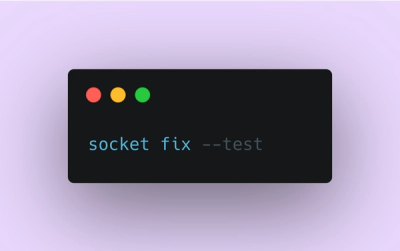
Product
Introducing Socket Fix for Safe, Automated Dependency Upgrades
Automatically fix and test dependency updates with socket fix—a new CLI tool that turns CVE alerts into safe, automated upgrades.
@nativescript-community/css-theme
Advanced tools
tns plugin add @nativescript-community/css-themeBe sure to run a new build after adding plugins to avoid any issues.
The theme will style your application using Element selectors - you don't need to add CSS classes on every element you need to style.
import "@nativescript-community/css-theme";
This JS takes care of updating several classes on the app root elements, something that got included in @nativescript/core in {N} 6.1.
Setting the theme mode from light to dark is now easier - instead of loading a new file, just find the root view and
set .ns-dark class to it - this will change all colorization to dark tones. For instance, if your page root is
RadSideDrawer, just add a class to it, like this:
<drawer:RadSideDrawer class="ns-dark" xmlns:drawer="nativescript-ui-sidedrawer">
...
</drawer:RadSideDrawer>
If your root is a frame, you can do this
<Frame class="ns-dark" defaultPage="root"></Frame>
For Angular, if your root is a page-router-outlet, you can set the .ns-dark class on it - it will pass it down to the
Frame it renders.
Setting the theme mode from JavaScript is also much easier now - just import the theme and call Theme.setMode() with your preferred mode - either Theme.Light or Theme.Dark, like this:
import Theme from "@nativescript-community/css-theme";
Theme.setMode(Theme.Dark); // Or Theme.Light
Keep in mind that in {N} 6.2 these changes will override the default system mode. To restore it, use Theme.Auto (available since Theme 2.3.0):
import Theme from "@nativescript-community/css-theme";
Theme.setMode(Theme.Auto);
Additionally there is another helper method - toggleMode, which can be used without parameters to just toggle the mode or with a boolean parameter to ensure light or dark mode is set:
import Theme from "@nativescript-community/css-theme";
Theme.toggleDarkMode(); // to toggle between the modes
// or
Theme.toggleDarkMode(true); // to ensure dark mode
Theme.toggleDarkMode(false); // to ensure light mode
Due to limitation in Playground the JS Theme API cannot be imported like an ES6 module in a TS/Angular projects. You'll have to resort to requiring it:
const Theme = require("@nativescript-community/css-theme");
Theme.setMode(Theme.Dark); // Or Theme.Light
In addition to .ns-light and .ns-dark classes, the theme's little JavaScript file introduces .ns-root on the root element,
.ns-android/.ns-ios depending on the current platform (which the theme extensively uses) and additionally
.ns-portrait/.ns-landscape and .ns-phone/.ns-tablet, which should be self-explanatory.
Of course .ns-portrait/.ns-landscape get updated on orientation change, so you can use it to show a two pane layout
in landscape, for instance.
There are several functions and mixins in the core theme, that can be used in your projects, as long as you're using SASS/SCSS.
If you need to access specific theme variables like simple colors or sizes, do it through the const function:
Button {
background-color: const(forest);
height: const(btn-height);
}
You can get light/dark colors:
Button {
color: light(primary);
.ns-dark & {
color: dark(primary);
}
}
FAQs
Nativescript ExtendedInfo plugin.
The npm package @nativescript-community/css-theme receives a total of 38 weekly downloads. As such, @nativescript-community/css-theme popularity was classified as not popular.
We found that @nativescript-community/css-theme demonstrated a healthy version release cadence and project activity because the last version was released less than a year ago. It has 19 open source maintainers collaborating on the project.
Did you know?

Socket for GitHub automatically highlights issues in each pull request and monitors the health of all your open source dependencies. Discover the contents of your packages and block harmful activity before you install or update your dependencies.

Product
Automatically fix and test dependency updates with socket fix—a new CLI tool that turns CVE alerts into safe, automated upgrades.

Security News
CISA denies CVE funding issues amid backlash over a new CVE foundation formed by board members, raising concerns about transparency and program governance.

Product
We’re excited to announce a powerful new capability in Socket: historical data and enhanced analytics.